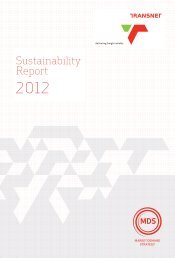BEN SCHOEMAN DOCK BERTH DEEPENING Specialist ... - Transnet
BEN SCHOEMAN DOCK BERTH DEEPENING Specialist ... - Transnet
BEN SCHOEMAN DOCK BERTH DEEPENING Specialist ... - Transnet
You also want an ePaper? Increase the reach of your titles
YUMPU automatically turns print PDFs into web optimized ePapers that Google loves.
5 DESCRIPTION OF THE AFFECTED ENVIRONMENT<br />
Carter et al. (2003) and Steffani et al. (2003) have provided environmental descriptions<br />
for Table Bay and the Port of Cape Town based on the available information for the<br />
region. The descriptions provided below are taken from these authors supplemented by<br />
survey data obtained subsequent to these syntheses. The environmental description is<br />
partitioned into a regional overview and site specific information on the proposed dredge<br />
areas in the Ben Schoeman Dock Basin and two candidate dredge spoil dump sites in<br />
outer Table Bay.<br />
5.1 Regional Overview<br />
5.1.1 Physical features<br />
Table Bay is a log spiral bay anchored by rocky headlands at Mouille Point in the south<br />
and Blouberg in the north and contains Robben Island and the important Port of Cape<br />
Town. Maximum water depth in the centre of the bay attains 35m, increasing to 70–80m<br />
outside of a line between Mouille Point and the western shores of Robben Island (Figure<br />
1).<br />
The seabed is mainly covered by thin layers of sand but has areas of partly exposed bed<br />
rock. Fine sand is generally confined to the eastern nearshore region between Blouberg<br />
and the harbour. However, a tongue of fine sediments extends from the nearshore zone<br />
seaward to a depth of approximately 25 m between Table View and Rietvlei. Smaller<br />
pockets of fine sand are found at the bay entrance and on the eastern shore of Robben<br />
Island. Medium sand covers the remaining areas of Table Bay (Figure 2; Woodborne<br />
1983; CSIR 1997). The major sources of the sand in Table Bay are seasonal (mainly<br />
winter) inputs from the Diep and Salt rivers and local erosion of Malmesbury shales<br />
(Quick and Roberts 1993). There is no substantial sediment supply to the bay from<br />
longshore transport from the south. Sediment is transported out of Table Bay by local<br />
wave and storm driven transport and the overall residence time for surficial sediments is<br />
estimated at 2-3 years (CSIR 1997).<br />
The shoreline of Table Bay (Figure 3) from Blouberg to Mouille Point consists of 3 km of<br />
rocky shore (at Blouberg and at Mouille Point), 13 km sandy beach (between Blouberg<br />
and Table Bay harbour) and 4 km of artificial shore protection and breakwaters<br />
comprising the Port of Cape Town (CMS 1998). Robben Island has a total shoreline of<br />
9km, of which 91% is rocky (CMS 1998).<br />
5.1.2 Oceanography<br />
Table Bay is located within the southern Benguela upwelling system and its circulation<br />
and water properties are characteristic of this region. Surface currents are mainly wind<br />
driven with velocity generally decreasing with depth. Quick and Roberts (1993) quote<br />
typical velocities as being 20 – 30 cm/s at the surface and near bottom flows being<br />
generally less than 5cm/s. Summer circulation in Table Bay is mainly clockwise.<br />
Nearshore currents are wave driven; waves approach the coast obliquely (200° - 260°<br />
predominantly) generating northward flow. Due to generally low current velocities water<br />
volume periods in Table Bay are generally long with an average period of 4 days (96<br />
hours) (Quick and Roberts 1993). This particularly applies to the bottom waters where<br />
van Ieperen (1971, cited in Quick and Roberts 1993) noted that currents were<br />
7

















